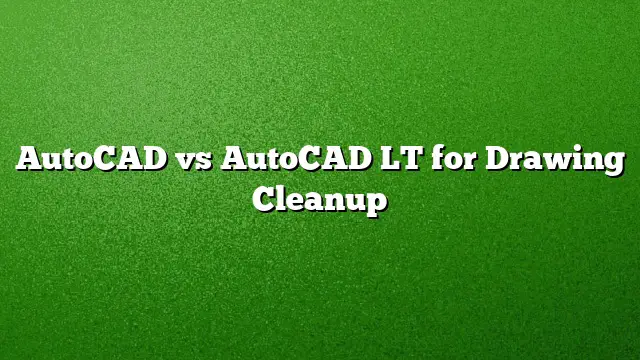Understanding the Challenge of Drawing Cleanup in AutoCAD
Receiving AutoCAD files from external sources that do not comply with your organization’s standards presents a common issue. Often, these files require extensive cleanup to adhere to specific guidelines. Many users face this dilemma, particularly when dealing with multiple files from the same provider. When confined to AutoCAD LT, the process can feel tedious and repetitive, as each file requires a set of separate adjustments.
Combining Files: A Handy Idea with Potential Pitfalls
To streamline the cleanup process, one might consider consolidating several files into a single drawing. This approach can be effective; however, it often leads to conflicts when different drawings use identical block names for separate items. This can create confusion and make the cleanup task even more complex than before.
Comparing AutoCAD vs AutoCAD LT in Drawing Cleanup
The Limitations of AutoCAD LT
For individuals using AutoCAD LT, the drawing cleanup process can feel slow and cumbersome. Below is a detailed step-by-step approach to cleaning up a hospital floor plan using AutoCAD LT.
- Open the received drawing file in AutoCAD LT.
- Freeze unnecessary layers that you do not need in the final version.
- Make all desired layers visible (unfreeze and turn on).
- Select everything in the drawing and execute the CUT command.
- Paste it into a new drawing, which we will call “drawing1.”
- Cut all text blocks and leaders from drawing1.
- Paste these elements into a second drawing, referred to as “drawing2.”
- Create a new layer called "background text."
- Merge all active layers into this new "background text" layer by using the LAYMERGE command. Make sure all layers are unlocked for this to function smoothly.
- Remove any layers that are off or frozen using the LAYDEL command. Press “N” for names to neatly delete unneeded layers.
- Return to drawing1 and create a new layer named "background."
- Merge all active layers into the "background" layer.
- Use LAYDEL again to clean out any remaining off or frozen layers.
- Run a purge operation on drawing1.
- Cut the background text from drawing2.
- Paste the text into drawing1.
- Finally, perform a purge, run an audit, and save your work.
The Efficiency of Full AutoCAD for Drawing Cleanup
Using the full version of AutoCAD 2025 enhances the cleanup process significantly with the introduction of the LAYTRANS command. This tool simplifies layer management and boosts efficiency. Here’s how to effectively utilize LAYTRANS for drawing cleanup.
- Open the incoming DWG file in AutoCAD 2025.
- Activate the LAYTRANS command to initiate layer translation.
- Select the load option and choose your company’s standard template file. If you’ve previously translated files for the same client, you can easily load the already saved layout.
- In the left panel, select the layers to be replaced (you can do this individually or in bulk).
- On the right panel, choose or create the appropriate target layers.
- Click the MAP button to link them.
- Validated layers will appear in the bottom panel as mapped, while those selected on the left will disappear.
- After you have mapped all desired layers, save the configuration as a DWG or DWS file.
- Press the translate button to execute the layer mapping.
- For subsequent drawings from the same architect or engineer, repeat the process but opt to load the previously saved DWS file.
This method significantly reduces the time spent on drawing cleanup, particularly for ongoing projects.
Frequently Asked Questions
1. What are the main differences between AutoCAD LT and AutoCAD for drawing cleanup?
AutoCAD LT lacks several features available in the full version, such as the LAYTRANS command, which streamlines layer management. As a result, users of AutoCAD LT often face a more labor-intensive cleanup process.
2. Can AutoCAD LT users still manage layers effectively?
While users of AutoCAD LT can manage layers, the process is less efficient and requires manual steps for each drawing. They must individually clean up blocks and merge layers, unlike full AutoCAD users who benefit from automated tools.
3. Is it possible to use AutoCAD LT for large projects?
AutoCAD LT can be utilized for large projects, but users may encounter limitations in functionality, especially regarding more complex layer management and automation features that can expedite tasks in the full version of AutoCAD.

